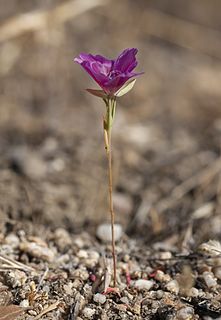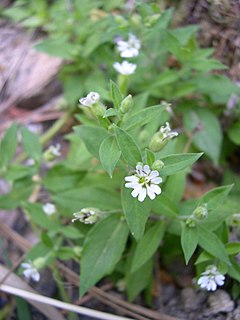
Draba densifolia is a species of flowering plant in the family Brassicaceae known as the denseleaf draba. This small perennial is native to western North America, where it is found in mountain environments above 2000 meters from California to Alaska to Wyoming. The plant forms cushion-like mats of small fleshy, hairy, pointed leaves in rocky crevices and on slopes. If it bolts a stem it is no taller than 15 centimeters. The flowers open in an obvious inflorescence of a few tiny blooms at times, but often appear as a layer on the surface of the mat of tiny leaves. The flowers are bright yellow with petals just a few millimeters wide. The fruit is a flat podlike silique less than a centimeter long.

Epilobium minutum is a species of willowherb known by the common names little willowherb, chaparral willowherb and desert willowherb. It is also called "smallflower willowherb" in reference to its small size relatively. However that name, in particular the British English variant "small-flowered willowherb", typically refers to Epilobium parviflorum.
Lasthenia microglossa is a species of flowering plant in the daisy family known by the common name smallray goldfields. It is endemic to California, where it grows in shady areas in a number of habitats.

Allium tribracteatum, known by the common name Threebract onion, is a species of wild onion found in California.
Chaenactis alpigena is a species of flowering plant in the daisy family known by the common name southern Sierra pincushion. It is native to the High Sierra Nevada and the White Mountains of California, extending in the latter just into Nevada.

Clarkia jolonensis is an uncommon species of flowering plant in the evening primrose family known by the common name Jolon clarkia. It is endemic to Monterey County, California, where it is known from the woodlands of the Central Coast Ranges.

Mimulus ringens is a species of monkeyflower known by the common names Allegheny monkeyflower and square-stemmed monkeyflower.
Psilocarphus elatior is a species of flowering plant in the aster family known by the common names tall woollyheads, meadow woollyheads and tall woolly-marbles. It is native to the Pacific Northwest in western North America from Vancouver Island, where it is known from just a few occurrences, to northern California. It grows in seasonally moist spots such as meadows, spring seeps, and vernal pools.

Sagina apetala is a species of flowering plant in the family Caryophyllaceae known by the common names annual pearlwort and dwarf pearlwort. It is native to Europe and it is known elsewhere as an introduced species, including parts of North America. It grows in many types of disturbed habitat, such as cracks in the sidewalk. It is a petite annual herb producing a threadlike stem just a few centimeters long, spreading or growing erect. The plant is glandular and somewhat hairy. The leaves are linear in shape and not more than about a centimeter long. The inflorescence is a solitary flower borne on a threadlike pedicel. The flower has usually four sepals and generally no petals.

Silene menziesii is a species of flowering plant in the family Caryophyllaceae known by the common names Menzies' campion and Menzies' catchfly. It is native to western North America from Alaska through the western half of Canada to the southwestern United States. It can be found in many types of habitat and it is quite common in much of its range. It is variable in morphology and there are a number of varied subtaxa. In general, it is a perennial herb growing from a caudex, appearing matlike, decumbent, or erect, with stems a few centimeters to over half a meter long. It is usually hairy in texture, with upper parts bearing sticky glandular hairs. The leaves are lance-shaped, oppositely arranged in pairs, and a few centimeters in length, upper leaves usually smaller than lower. Flowers may occur in a cyme at the top of the stem, or in leaf axils, or both. Each is encapsulated in a hairy, veined calyx of fused sepals. The petals are white with two lobes at the tips. The plant is dioecious with male and female plants producing different flowers. The male and female flower types look the same externally; the stamens are reduced in female plants and the stigmas are reduced in the male.
Streptanthus batrachopus is a rare species of flowering plant in the mustard family known by the common name Mt. Tamalpais jewelflower. It is endemic to Marin County, California, where it is known only from Mt. Tamalpais and surrounding terrain. There are fewer than ten known occurrences.
Juncus digitatus is a rare species of rush known by the common name finger rush. It is endemic to Shasta County, California, where it is known from only two occurrences near Shingletown. It occurs in spring-moist habitat such as vernal pools in sunny locations in the foothills of the southernmost Cascade Range. The plant was first collected in 1991 and described to science as a new species in 2008.

Trichophorum is a genus of flowering plants in the sedge family, Cyperaceae. Plants in this genus are known as deergrasses in Britain but are sometimes known as bulrushes in North America. It contains the following species:

Polygala lewtonii is a rare species of flowering plant in the milkwort family known by the common name Lewton's polygala, or Lewton's milkwort. It is endemic to Florida in the United States, where it is limited to the central ridge of the peninsula. There are about 49 occurrences of the plant remaining. Most occurrences contain very few plants. The species is threatened by the loss and degradation of its habitat. This is a federally listed endangered species of the United States.

Pyrrocoma clementis is a species of flowering plant in the aster family known by the common name tranquil goldenweed. It is native to Colorado, Utah, and Wyoming in the United States.

Alpine bulrush or cotton deergrass is a species of flowering plant in the sedge family. It has a circumboreal distribution, occurring throughout the northern latitudes of the Northern Hemisphere. It is present in Europe, Asia, and northern North America.

Nemastylis floridana is a species of flowering plant in the family Iridaceae known by the common names Florida celestial, fallflowering pleatleaf, and fallflowering ixia. It is endemic to Florida in the United States, where it faces many threats to its existence, but so far remains viable.
Trichophorum clintonii, the Clinton's bulrush, is a plant species native to Canada and the northeastern United States. It has been reported from Alberta, Saskatchewan, Ontario, Québec, New Brunswick, Maine, New York State, Michigan, Wisconsin, and Minnesota.

Trichophorum cespitosum, commonly known as deergrass or tufted bulrush, is a species of flowering plant in the sedge family. It was originally described by the Swedish naturalist Carl Linnaeus in 1753 as Scirpus cespitosus, but was transferred to the genus Trichophorum by the Swedish botanist Carl Johan Hartman in 1849, becoming Trichophorum cespitosum.
Saurauia clementis is a species of flowering plant in the family Actinidiaceae. It is endemic to the Philippines. Elmer Drew Merrill, the American botanist who first formally described the species, named it after Mary Strong Clemens, the American botanist who collected the specimen that he examined.












